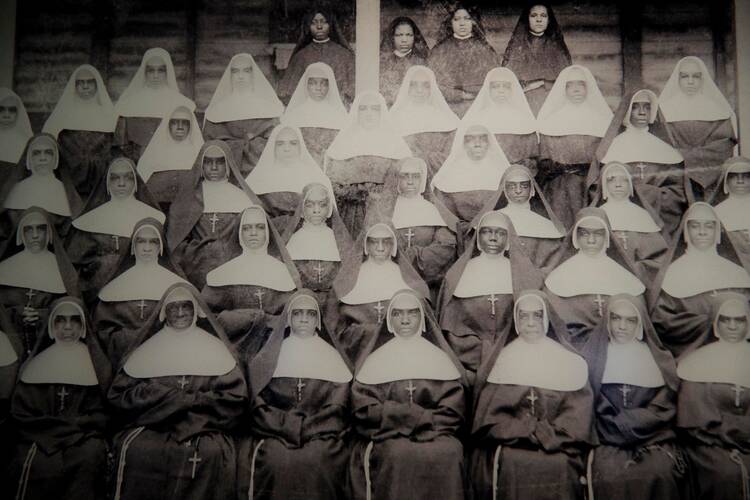As a historian and frequent lecturer in Catholic history, I often rhetorically ask the question: What would happen if we narrated the history of the United States (and wider American) Catholic experience from the perspective of Black women and Black girls? And my answer is always the same: Myths about the Catholic past fall quickly and hard.
As such, I read America’s coverage of the Sisters of Charity of New York’s recent decision to stop accepting members and formally embark on the path to completion, “Nerves, Tears and Chanting,” with shock and disappointment.
The steady decline in the number of women religious in the West and the increasing decisions of surviving communities to either merge with other congregations and/or accept their demise demand a full reckoning with the impact of the longstanding (and in some cases enduring) anti-Black and anti-brown admissions policies and practices that most European and white American congregations employed in this country and beyond. I found the article’s erasure of the congregation’s long and mostly unreconciled history of white supremacy and racial exclusion in their ranks and most of their institutions completely unacceptable.
What would happen if we narrated the history of the United States (and wider American) Catholic experience from the perspective of Black women and Black girls?
The author, Sherryl White, C.S.J., writes:
The birthright of the Sisters of Charity of New York is a loving commitment to service, especially to those living in poverty. When you stand in their presence, you stand with those they serve. They call to mind for me the words of Johann Baptist Metz, who spoke of the importance of holding the dangerous memory of the marginalized poor, of bringing that awareness to rattle the doors of the church. These sisters who meld mission with ministry to those in need are giants who shake the consciences of all with hearts to see.
But the actual dangerous memories in this complicated story are the Sisters of Charity of New York’s slaveholding roots and their decades-long history of racial segregation and exclusion in the United States and in the Bahamas, where their exclusionary admission policies also initially barred Black women and girls from membership and prompted the formation of a short-lived all-Black Bahamian congregation separate from their order.
In 1853, a Black Catholic laywoman named Harriet Thompson famously wrote to Pope Pius IX detailing the foundational and hateful white supremacist commitments of New York City’s white Catholic leaders. In her letter, Ms. Thompson specifically noted how the Sisters of Charity in the city, born of the slaveholding congregation established in Maryland by St. Elizabeth Seton, refused to educate the city’s “colored Catholic children.” Because the testimonies and lived experiences of Black Catholic women and girls have been so marginalized, disregarded and ignored in church history, the preservation and dissemination of Ms. Thompson’s plea to the Vatican, first documented in Cyprian Davis’s The History of Black Catholics in the United States, is a miracle of sorts. And the prophetic voice, witness and protest of Harriet Thompson still call to us today.
The greatest weapon of white supremacy has never been violence but rather the ability to erase the history of its violence and its victims.
In the conclusion of my 2022 book, Subversive Habits, which provided the first full survey of the lives and struggles of Black Catholic sisters in the United States, I expressed cautious hope about the ability of the Catholic Church to confront, reckon with and make reparation for its tremendous history of anti-Black racism and misogynoir (anti-Black misogyny), including and especially within the lives of women religious. But I also wrote:
Popular and many scholarly narrations of women’s religious life overwhelmingly still either minimize white sisters’ histories as enslavers or segregationists or erase them altogether. Moreover, Black Catholics’ lived experiences remain overlooked as essential sources for understanding and assessing the church’s place in the history of American racism and the global phenomenon of anti-Blackness.
The ongoing failure of church scholars and journalists to acknowledge and take seriously the full impact of white supremacy on Catholic institutions and culture is a searing testament to the church’s continued failure to serve as a true and living witness for all people. Historical erasure is an act of violence. There can be no true justice, reconciliation or peace without confronting, acknowledging and making reparation for the enduring sins of white supremacy, anti-Blackness and misogynoir in the Catholic Church.
In publishing this piece without acknowledging the Sisters of Charity of New York’s slaveholding roots and histories of segregation, America has done a great disservice to its readers and those who suffered and continue to suffer and die under the scourge of white supremacy and racial exclusion in the Catholic Church and wider society. It also underscores what historians of the Black experience have always understood: The greatest weapon of white supremacy has never been violence but rather the ability to erase the history of its violence and its victims. Catholic institutions, including media outlets, have a special obligation to stand against any attempt to ignore, misrepresent and erase the past and present in favor of false narratives of inherent white virtue and innocence.
Long live the prophetic witness of Harriet Thompson and all the unsung and not-yet-known Harriet Thompsons in Catholic history! May all Catholics and Americans know their stories, which offer a more honest and just accounting of the U.S. Catholic experience.








